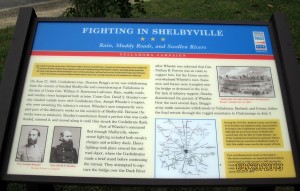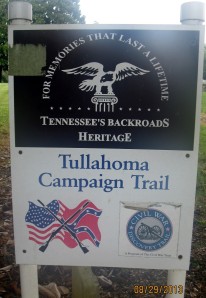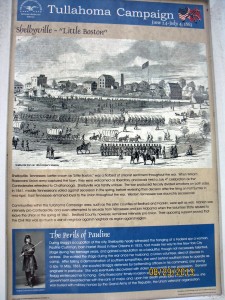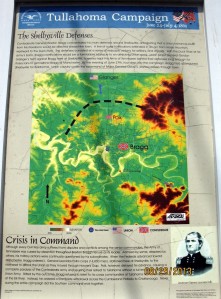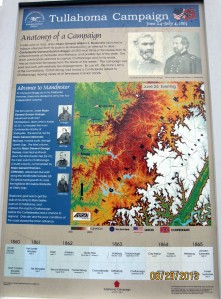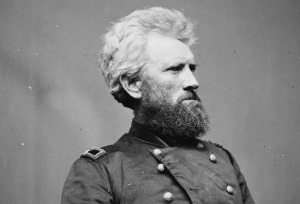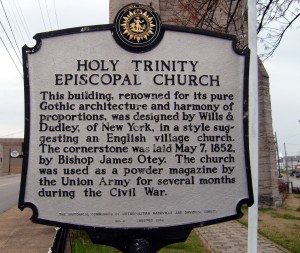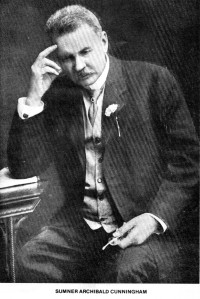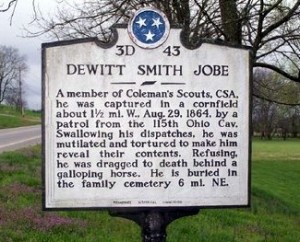This past week during our “Shelbyville In The Middle” (see previous post), some were asking, “Why is the war in the United States from the period of 1861-1865 called The Civil War, The War Between The States, or any other name”? I decided to search the web for some thoughts and insights from those more knowledgeable. This is my modest attempt to present some of those opinions, but first let us define a civil war, since the majority of people call it “The Civil War”.
Political scientists use two criteria to define a civil war:
- The warring groups must be from the same country and fighting for control of the political center, control over a separatist state or to force a major change in policy.
- At least 1,000 people must have been killed in total, with at least 100 from each side.
A pamphlet was put together by Edmond S. Meany of the University of Washington for the purposes of clarifying the official name of the war. Meany had heard Senator Benjamin Tillman present a speech in which he described the war as “The War Between the States” as the official name adopted by the federal government. Meany contacted Tillman and asked for documents related to the Senate debate and discovered that in fact the name adopted was “Civil War.” Here is an excerpt from that Senate debate for your consideration. The debate took place on January 11, 1907 and can be found in the Congressional Record of that date, pages 929 to 933. (Note: I attempted to locate this record to verify, but was unable)
Mr. Teller (Colorado): “So it can be said to have been a war between the states.
Then, in addition to that, those warring States, if they were warring States, entered into a confederacy and established a new government. It may possibly be stated that it was a war of the Confederacy against the United States.
Mr. President, it is not very material whether you use the term “rebellion” or whether you do not. I insist that the term “rebellion” is a proper term. It describes the condition which existed from 1861 to 1865. It may be an offensive term; and yet it was a rebellion against the Government of the United States. We have called it a civil war. At first there was a disposition to feel that those people were not entitled to be treated as warriors under the rules of national war. But it was found to be so great a war that they must be so treated. They were so treated by foreign governments, as well as by our own.
When the war closed there was no treaty between the States and the General Government. There was no recognition of State lines at all. In every respect the war was treated as a war of citizens of the United States against the General Government. It will go down in history of the world as a rebellion of States, in the first instance, because the States did act. Then it became in the highest sense of the term, a civil war, a conflict between individual citizens of the United States, and upon that theory when the war was over the Republican party declared that each of those States had practically abandoned its organization.
Upon that question I do not care to take much time. I was disposed myself, although an ardent supporter of the war, to believe that we ought to have recognized the existence of the States, upon the theory that the States had not gone out of the Union at all, and that the difficulty had arisen by the action of the individual citizenship of the States and not be the States.
However, the party in power at that time did not so recognize the condition and the States were finally brought back into the Union, as it was said, which, according to my theory, they had never been out of.
I do not think it very important whether we call it the war of the rebellion or the civil war. I do not believe that now or at any other time will we be inclined, or the people of the United States will be inclined, to change the character of the war by declaring it to have been a war between the States. It was a war against the general Government by citizens of the United States who were in rebellion against the authority of the General Government at that time.”
Mr. Money (Mississippi): I do not consider, having been a rebel from start to finish, that there is any particular odium in that phrase. George Washington was a rebel.
Mr. Teller: Certainly
Mr. Money: And so were all the heroes and patriots who established this Government. Some of them were slaveholders, including George Washington. There is nothing oprobrious in the term “war of the rebellion.” If it suits the fancy of Senators to call it by that name, it does not hurt me. I am quite accustomed to it, and I do not mind. But I was simply suggesting phraseology to meet the history of the case better. If Senators want to call it the civil war, they can do so. We contend it was not a civil war. It is quite true that men in Tennessee to the number of 32,000 went into the Federal Army, and I believe every single Southern State, except the State of Mississippi, furnished a regiment to the Federal Army. Mississippi furnished one, which was called the “Tigers” It was not composed of Mississippians, but of the fragments of regiments–the sick and wounded Federal soldiers at Vicksburg. But Mississippi was a wholly rebel, to use a common phrase, as any State could possibly be.
Kentucky and Maryland and Missouri sent the very flower of the Confederate army into the field. The best fighting men I ever saw came from those States, for the reason that they were not compelled to go to the front by local opinion, but went to the front contrary to that opinion, as many of them had to run the lines to get there, and they made all kinds of sacrifices.
I admit that if I had been in Massachusets I would have been in the Federal Army, and I guess if the Senator from Colorado [Mr. Teller] had been living in my town he would have been a member of my company; and I am not at all blaming anybody for the attitude he took at that time.
Mr. President, I do not want to take up time, but I happened to be at the door of the lobby of the Senate one day not long ago. It was the last session, near the close. There was ex-Senator Blair, of New Hampshire, as gallant a soldier as ever went to the field, now on crutches as the result of wounds inflicted by Confederate soldiers. He was shot three or four times. He called to me. I did not recognize him on account of my bad sight. We shook hands. I said: “What are you doing on these sticks, Blair?” He said: “You fellows hit me pretty hard three or four times, and it is beginning to tell on me since I have been getting old.” He said: “Did we get you?” I said: “Once; not much.” He said: “Are you not glad you got it?” I said: “I do not know. I have not regretted it.” He said: “I am glad I was hit.” We shook hands. He said: “Any man who was worth being hit ought to have been there either on one side or the other. If you had been in New Hampshire you would probably have been in my regiment.” I agreed that it was a great deal a matter of environment.
from “Civil War or War Between the States?” by Kevin Levin
So What’s in a Name?
For well over a century individuals and organizations with strongly held convictions have rejected use of the term “Civil War” to designate the American conflict of 1861-1865. Most commonly offered as an alternative has been “War Between the States.” Lesser support has been voiced for the “Confederate War,” the “War for Southern Independence,” and the “War of the Rebellion.” Usually put forward by southerners with tongue in cheek have been the “War of [or Against] Northern Aggression” and “The Late Unpleasantness.”
During the course of the conflict no consensus developed around terminology. Yet, evidence can be found, even before Fort Sumter, for the use of the term “civil war.” Staunton, Virginia, newspapers in 1860 warned that the prevailing crisis “would lead directly and inevitably to disunion and civil war.” Raphael Semmes tendered his resignation from the U.S. Navy with the caution that “civil war is a terrible crucible.” Jefferson Davis, soon to be Confederate president, resigned his post in the U.S. Senate, warning that Abraham Lincoln’s policies would “inaugurate a civil war.” (After the war Davis did endorse use of “War Between the States.”)
Gen. Robert E. Lee in a January 1861 letter home wrote, “I see no cause of disunion, strife & civil war & I pray it may be averted.” Two years later, on the death of his daughter Annie, General Lee wrote, “I have always counted, if God should spare me a few days after this Civil War was ended, that I should have her with me.” Examples can be offered for use of the term during the war by other Confederate officers, among them P. G. T. Beauregard and Nathan Bedford Forrest.
Notwithstanding the fact that Lincoln at Gettysburg intoned, “Now we are engaged in a great civil war,” the term favored by many in the North during and for decades after the conflict was the “War of the Rebellion” or simply “The Rebellion.” Publication of the multivolume series of war documents under the title The War of the Rebellion: A Compilation of the Official Records of the Union and Confederate Armies conferred federal sanction on the usage. Among the first to use “War Between the States” (a term virtually unknown during the conflict) was Confederate vice-president Alexander H. Stephens, whose book by that title appeared in 1866. For the remainder of the nineteenth century, veterans of the conflict divided over usage. Confederate general Joseph E. Johnston used “War Between the States” in the title of his 1874 memoir. Zebulon B. Vance, North Carolina’s wartime governor and champion, in public addresses in 1886 and 1889 referred to the “late civil war.”
The United Daughters of the Confederacy moved the argument to center stage at the close of the nineteenth century. Rejecting “Civil War Between the States,” a term favored by the United Confederate Veterans, the women of the UDC moved foursquare behind “War Between the States” and enacted a public campaign for its wide adoption. Mrs. L. E. Williams in 1917 succinctly expressed the rationale, writing that use of “Civil War” constituted a “complete surrender of the basic principle upon which the war was waged, the right of self-government.” The UDC membership was zealous in protecting southerners against what they viewed as northern propaganda, targeting particularly schoolrooms and textbooks.
Objection to the use of “Civil War” peaked in the second decade of the twentieth century. In 1913, at the behest of the UDC, a Georgia congressman introduced a resolution officially renaming the conflict the “War Between the States.” Referred to a committee, it never made it to the House floor. In 1914, proponents placed on the ballot in North Carolina a constitutional amendment to strike references to “insurrection or rebellion” in the 1868 constitution and substitute “War Between the States.” The proposal failed by a vote of 61,031 to 57,816.
The appeal for southern orthodoxy encouraged by the UDC had results, though sometimes unintended. Sympathetic southern newspaper editors, eager to be compliant and to avoid a letter-writing campaign, instructed staff to alter wire service copy. The New Orleans Times-Picayune identified an aviator who flew against Franco as having participated in the Spanish War Between the States!
By 1961, and the observance of the war’s centennial, as Louisiana State University historian Gaines Foster has observed, “the memory of the conflict no longer touched southern lives in the way it once had.” Still, many former Confederate states chose to use “War Between the States” in naming their commemorative boards. In North Carolina, officials avoided that appellation by creating the Confederate Centennial Commission.
With the passage of time, the debate over terminology, once freighted with enormous ideological implications, has subsided and today Southerners generally accept the use of the term “Civil War.” Among modern-day professional historians there is no debate over whether to use the phrase. John M. Coski of the Museum of the Confederacy examined the history of the “war between the names” in the January 2006 issue of North & South, writing that “students of the war also need a name that they can use not to provoke discussion, but merely to designate the subject of their study—a name that is a common currency.” He concluded, “That common currency is Civil War.”
from the 2013 North Carolina Department of Cultural Resources
This site will use the U.S. “Civil War” or the “War Between The States”, interchangeably.



